Physical Address
304 North Cardinal St.
Dorchester Center, MA 02124
Neuromuscular diseases are a complex group of disorders that typically present with weakness, muscle pain, or sensory deficits and may be inherited or acquired. They can be grouped according to anatomy, disease course, and pathogenesis. Physicians keep all these characteristics in mind when evaluating a patient with neuromuscular symptoms. This chapter uses an anatomic approach, grouping neuromuscular disorders into those that preferentially affect the peripheral nerves, the neuromuscular junction, or the skeletal muscles. A discussion of neoplasms that arise from peripheral nerves ends the chapter. Conditions that can produce similar clinical symptoms but are caused by disorders of the central nervous system (CNS) are discussed in Chapter 28 .
The two components of peripheral nerves involved in impulse transmission are axons and myelin sheaths made by Schwann cells. Injury to either of these components may result in a peripheral neuropathy. Before discussing the pathology of these disorders, a brief review of peripheral nerve structure and function is in order. Somatic motor function is carried out by the motor unit, which consists of (1) a lower motor neuron located in the anterior horn of the spinal cord or in the brainstem; (2) an axon that travels in a nerve to a target; (3) the neuromuscular junctions; and (4) multiple innervated myofibers (muscle fibers). Somatic sensory function depends on (1) the distal nerve endings, which may contain specialized structures that serve to register specific sensory modalities; (2) a distal axon segment that travels as part of a peripheral nerve to the dorsal root ganglion; and (3) a proximal axon segment that synapses on neurons in the spinal cord or brainstem. Autonomic nerve fibers, which transmit all visceral motor and sensory functions, outnumber somatic fibers in the peripheral nervous system, but signs and symptoms related to their involvement are generally not prominent features of peripheral neuropathies, with a few important exceptions (e.g., in some cases of diabetic neuropathy, discussed later).
Specific sensations (pain, temperature, touch) and motor signals are each conveyed by axons that can be distinguished, in part, based on their diameter. Axonal diameters are in turn correlated with the thickness of their myelin sheaths and with their conduction speeds:
Thin unmyelinated fibers mediate autonomic functions as well as certain pain and temperature sensations and have the slowest conduction speeds due to their lack of myelin and small axonal diameter.
Large diameter axons with thick myelin sheaths transmit light touch and motor signals and have fast conduction speeds.
In the case of myelinated axons, individual Schwann cells make exactly one myelin sheath that wraps around a single axon to create a myelinated segment called an internode . Internodes are separated by unmyelinated gaps referred to as nodes of Ranvier, which are uniformly spaced along the length of the axon. A number of specialized proteins are essential for normal assembly and function of myelin within internodes ( Fig. 27.1 ). Unmyelinated axons are also intimately associated with Schwann cells but in a different arrangement in which one cell surrounds segments of multiple axons.
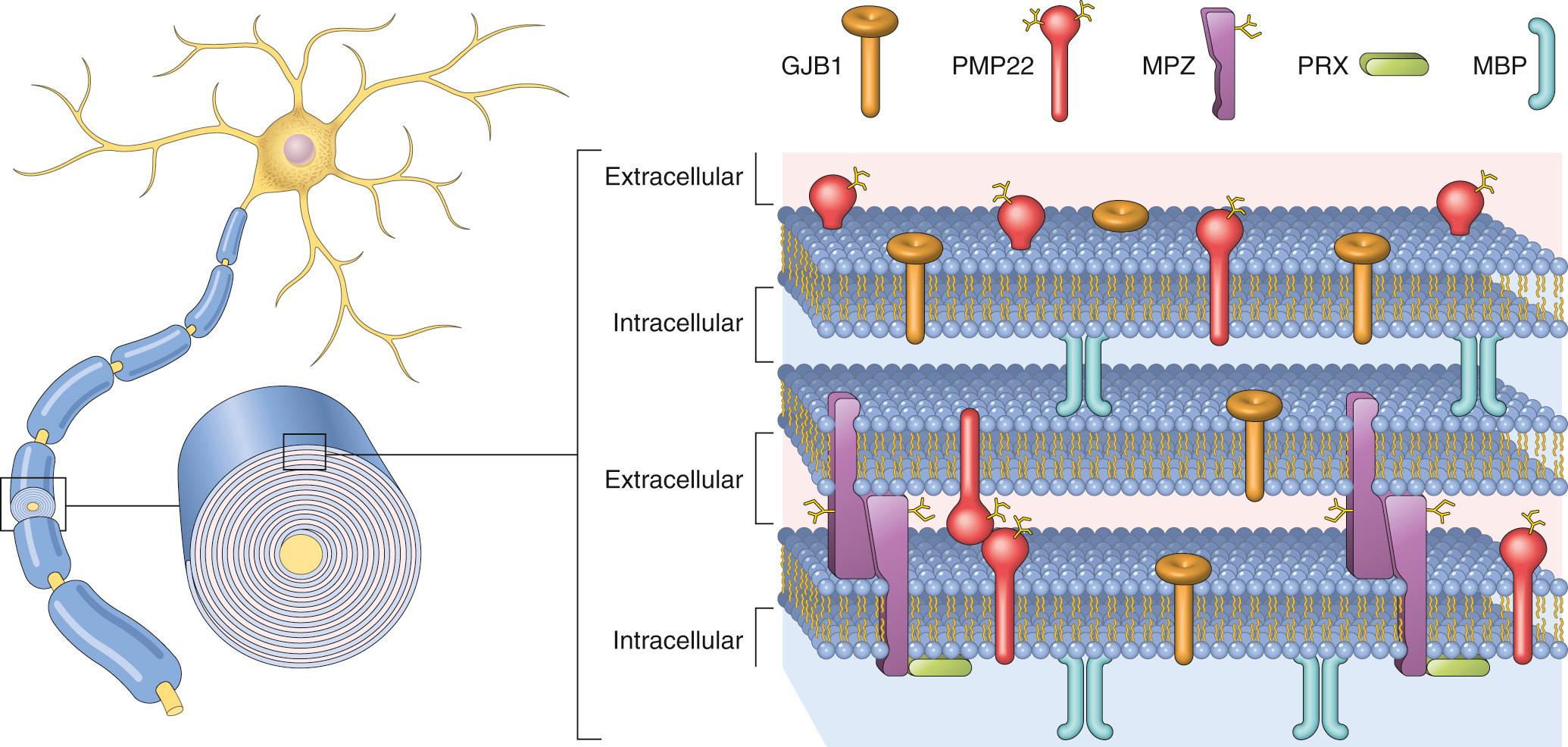
Most peripheral nerves carry out both motor and sensory functions and thus contain axons of varying diameter and myelin thickness. The axons are bundled together by three major connective tissue components: the epineurium, which encloses the entire nerve; the perineurium, a multilayered concentric connective tissue sheath that groups subsets of axons into fascicles; and the endoneurium, which surrounds individual nerve fibers.
Axons are the primary target of the damage in this large group of peripheral neuropathies ( Fig. 27.2 ). The morphologic hallmarks of axonal neuropathies can be produced experimentally by cutting a peripheral nerve, which results in a prototypical pattern of injury described as Wallerian degeneration . Portions of axons that are distal to the point of transection are disconnected from the cell bodies (perikarya) and degenerate. Within a day of injury, the distal axons begin to fragment, and the associated myelin sheaths unravel ( Fig. 27.3 ) and disintegrate into spherical structures (myelin ovoids). Macrophages are recruited and participate in the removal of axonal and myelin debris. Regeneration starts at the site of transection with the formation of a growth cone and the outgrowth of new branches from the stump of the proximal axon. Schwann cells and their associated basement membranes guide the sprouting axons, which grow at about 1 mm per day, toward their distal target. Continuous pruning of the sprouting axons removes misguided branches. The Schwann cells create new myelin sheaths around the regenerating axons, but these myelin internodes tend to be thinner and shorter than in the original ones. The regeneration is successful only if the two transected ends remain closely approximated. A failure of the outgrowing axons to find their distal target can produce a “pseudotumor” termed traumatic neuroma —a nonneoplastic haphazard proliferation of axonal processes and associated Schwann cells that results in a painful nodule ( Fig. 27.4 ).
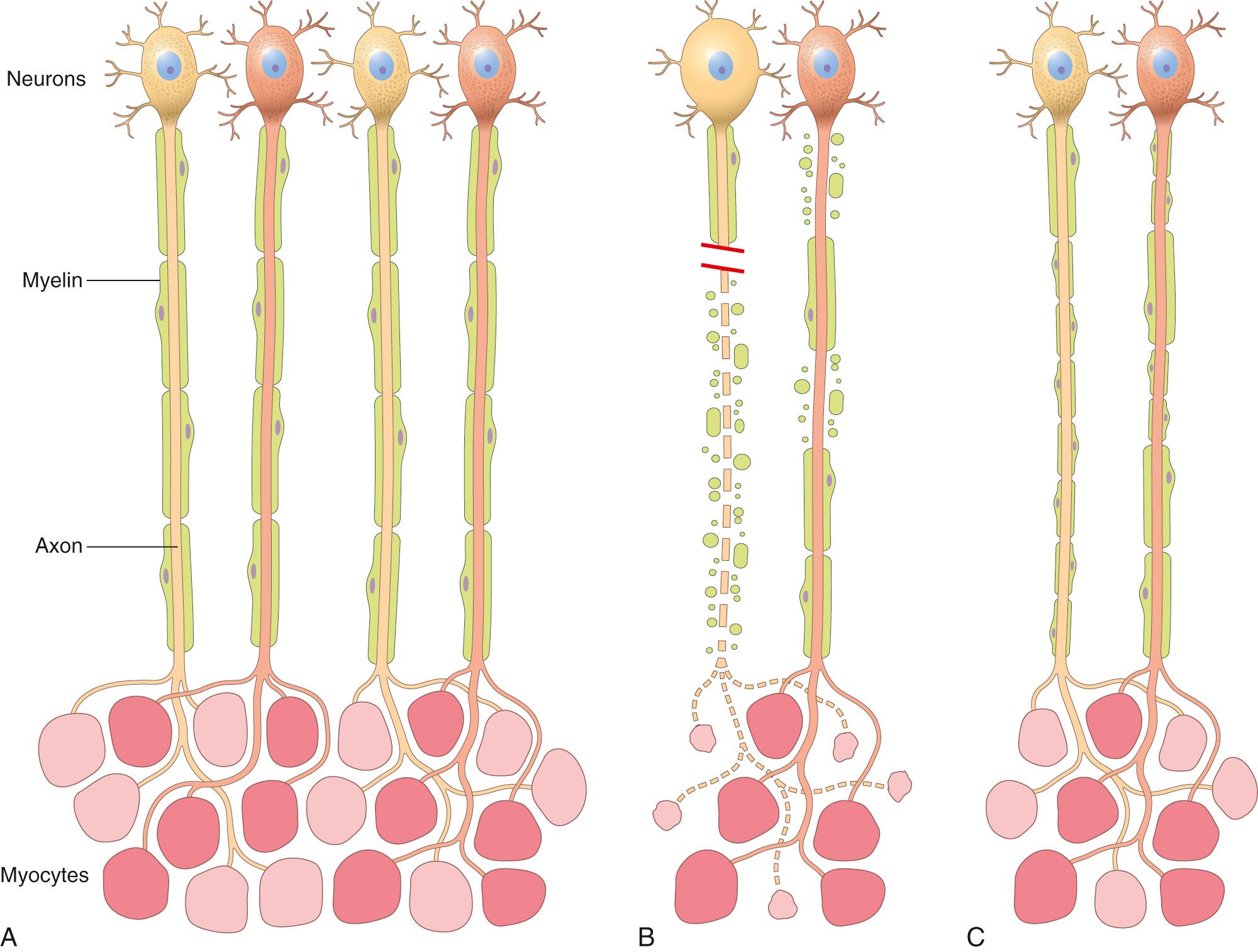
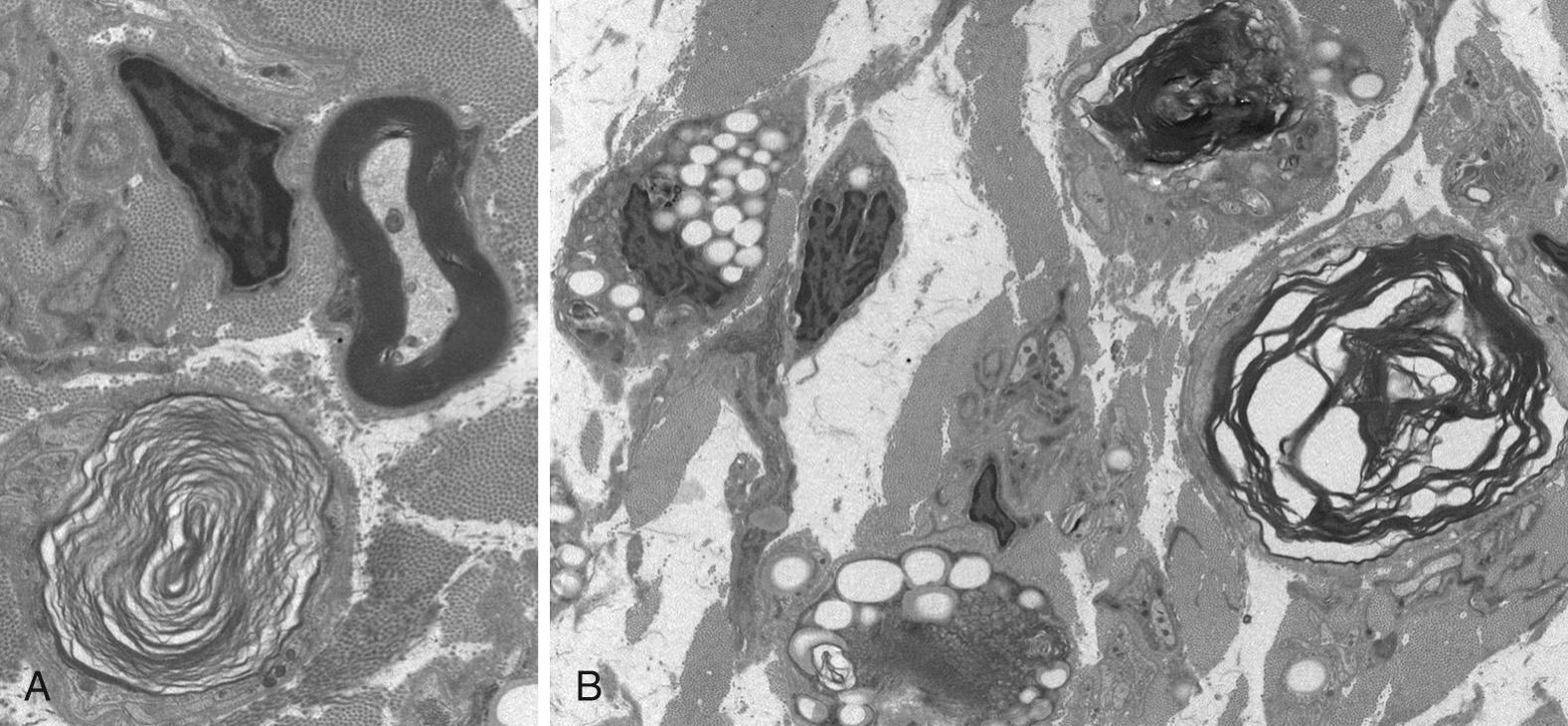
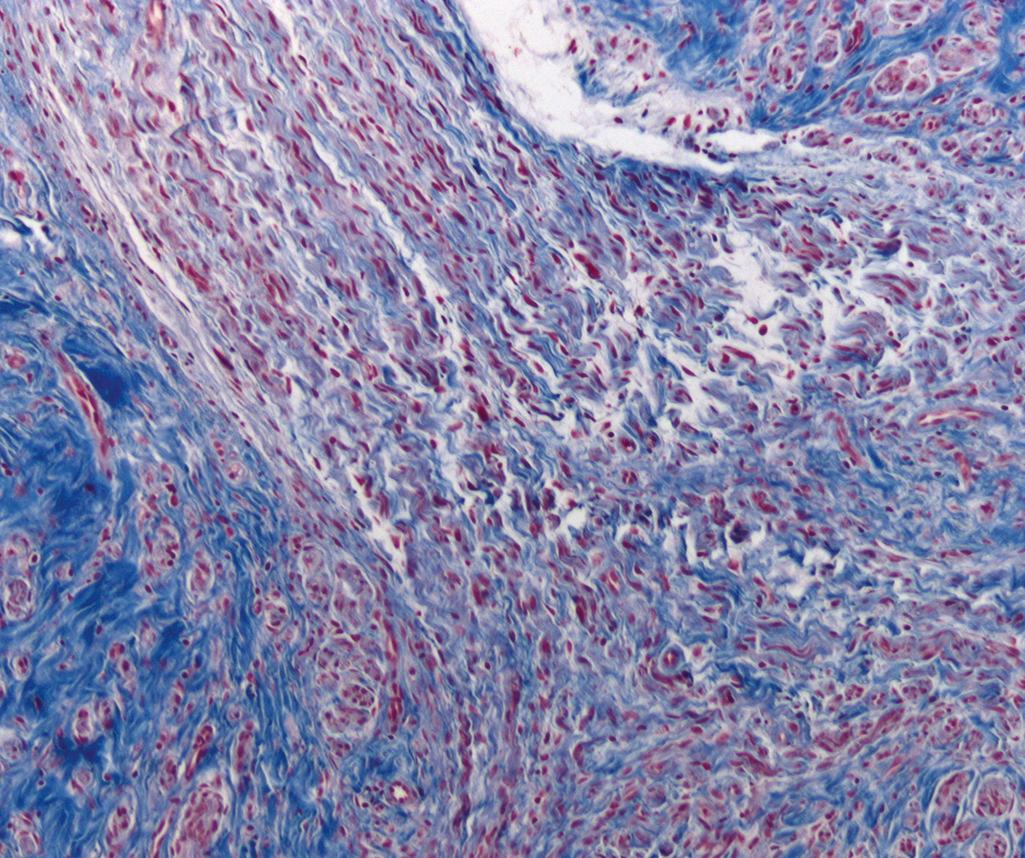
The changes observed following experimental nerve transections only partially resemble those seen in various axonal neuropathies. One key difference is that in these neuropathies (unlike nerve transection) damage occurs over an extended period of time. As a result, degenerating and regenerating axons coexist in a single biopsy. With time, damage tends to outpace repair, resulting in progressive loss of axons. In cases of toxic and metabolic insults, axons often degenerate in a length-dependent fashion with the longest axons being most susceptible, resulting in a “dying-back” type of pattern of progression. The electrophysiologic hallmark of axonal neuropathies is a reduction in signal amplitude owing to the dropout of axons from affected peripheral nerves, with relative preservation of conduction velocity.
In these disorders, Schwann cells with their myelin sheaths are the primary targets of damage (see Fig. 27.2 ), whereas axons are relatively preserved. This definition is similar to that of demyelinating diseases that affect the CNS ( Chapter 28 ). Individual myelin sheaths degenerate in a seemingly random pattern, resulting in discontinuous damage of myelin segments. In response to this damage, Schwann cells or Schwann cell precursors proliferate and initiate repair through the formation of new myelin sheaths, but these again tend to be shorter and thinner than the original ones. The electrophysiologic hallmark of demyelinating neuropathies is slowed nerve conduction velocity, reflective of the loss of myelin.
Neuronopathies result from destruction of neurons, leading to secondary degeneration of axonal processes. Infections like herpes zoster and toxins like platinum compounds are examples of insults that may lead to neuronopathies. Because the damage is at the level of the neuronal cell body, peripheral nerve dysfunction caused by neuronopathies is equally likely to affect proximal and distal parts of the body (unlike peripheral axonopathies, which preferentially affect the distal extremities).
Peripheral neuropathies can be separated into several groups according to the anatomic distribution of involvement and the associated neurologic deficits. This approach can be helpful clinically, since each pattern has a different set of potential underlying causes. These anatomic patterns of injury are as follows:
Mononeuropathies affect a single nerve and result in deficits in a restricted distribution dictated by nerve anatomy. Trauma, entrapment, and infections are common causes of mononeuropathy.
Polyneuropathies are characterized by involvement of multiple nerves, usually in a symmetric fashion. In most cases axons are affected in a length-dependent fashion leading to deficits that start in the feet and ascend with disease progression. The hands often start to show involvement by the time deficits extend to the level of the knee, resulting in a characteristic “stocking and glove” distribution of sensory deficits.
Mononeuritis multiplex describes a disease process that damages individual nerves in a haphazard fashion. An affected patient might have a right wrist drop from involvement of the right radial nerve and a left foot drop from peroneal nerve damage. Vasculitis is a common cause of this pattern of injury.
Polyradiculoneuropathies affect nerve roots as well as peripheral nerves, leading to diffuse symmetric symptoms in proximal and distal parts of the body.
Patients with peripheral neuropathy often complain of numbness, painful “pins and needles” sensations, and weakness, most often in the distal portions of the extremities. Many different types of disease processes can damage peripheral nerves, including inflammatory diseases, infections, metabolic changes, toxic injury, trauma, paraneoplastic disease, and inherited gene defects.
Guillain-Barré syndrome is an immunologically mediated demyelinating peripheral neuropathy that may lead to life-threatening respiratory paralysis. The overall annual incidence is approximately 1 case per 100,000 persons. The disease is characterized clinically by weakness beginning in the distal limbs that rapidly advances to affect proximal muscle function (“ascending paralysis”). Histologic features are inflammation and demyelination of spinal nerve roots and peripheral nerves (radiculoneuropathy).
In most cases, Guillain-Barré syndrome is thought to be an acute-onset immune-mediated demyelinating neuropathy. Approximately two-thirds of cases are preceded by an acute, influenza-like illness from which the affected individual has recovered by the time the neuropathy becomes symptomatic. Infections with Campylobacter jejuni, cytomegalovirus, Epstein-Barr virus, and Mycoplasma pneumoniae as well as prior vaccination have significant epidemiologic associations with Guillain-Barré syndrome. No infectious agent has been demonstrated in affected nerves, and an immunologic reaction is favored as the underlying cause. A similar inflammatory disease of peripheral nerves can be reproduced in experimental animals by immunization with a peripheral nerve myelin protein. A T-cell–mediated immune response ensues, accompanied by segmental demyelination induced by the actions of activated macrophages. Transfer of these T cells to a naive animal results in comparable lesions. Moreover, lymphocytes from individuals with Guillain-Barré syndrome have been shown to produce demyelination in tissue cultures of myelinated nerve fibers. Circulating antibodies that cross-react with components of peripheral nerves may also play a role.
The dominant finding in sections stained with hematoxylin and eosin is inflammation of peripheral nerves, manifested as perivenular and endoneurial infiltration by lymphocytes, macrophages, and a few plasma cells. Segmental demyelination affecting peripheral nerves is the most prominent lesion, but damage to axons is also seen, particularly when the disease is severe. Electron microscopy has identified an early effect on myelin sheaths. The cytoplasmic processes of macrophages penetrate the basement membrane of Schwann cells, particularly in the vicinity of the nodes of Ranvier, and extend between the myelin lamellae, stripping the myelin sheath from the axon. Ultimately, the remnants of the myelin sheath are engulfed by the macrophages. Inflammation and demyelination can be widespread in the peripheral nervous system but are typically most prominent proximally, close to the nerve roots.
The clinical picture is dominated by ascending paralysis and areflexia. Deep tendon reflexes disappear early in the process. Sensory involvement, including loss of pain sensation, is often present but is usually not a prominent feature. Nerve conduction velocities are slowed because of multifocal destruction of myelin segments in many axons within a nerve. Cerebrospinal fluid (CSF) protein levels are elevated due to inflammation and altered permeability of the microcirculation within the spinal roots as they traverse the subarachnoid space. Inflammatory cells, on the other hand, remain confined to the roots; therefore, there is little or no CSF pleocytosis. Many patients spend weeks in the intensive care unit (ICU) before recovering normal function. With improved supportive respiratory care, cardiovascular monitoring, and prophylaxis against deep venous thrombosis, the mortality rate has fallen. Plasmapheresis and intravenous immunoglobulin therapy hasten recovery, apparently because these remove pathogenic antibodies and suppress immune function, respectively. However, 2% to 5% of affected patients die of respiratory paralysis, autonomic instability, cardiac arrest, or related complications, and up to 20% of hospitalized survivors suffer long-term disability.
This is the most common chronic acquired inflammatory peripheral neuropathy, characterized by symmetric mixed sensorimotor polyneuropathy that persists for 2 months or more. By definition, signs and symptoms must be present for at least 2 months, but often the disease evolves over years, usually with relapses and remissions. Typically there is a symmetric, mixed sensorimotor polyneuropathy, but some patients may present with predominantly sensory or motor impairment. Clinical remissions can often be achieved with intravenous immunoglobulin, or with other immunosuppressive therapies, such as plasmapheresis, glucocorticoids, and cytotoxic agents directed against T cells or B cells. The time course and the response to steroids distinguish chronic inflammatory demyelinating polyradiculoneuropathy from Guillain-Barré syndrome.
T cells as well as antibodies are implicated in the inflammatory process. Molecules expressed at the Schwann cell–axon junction and in noncompact areas of myelin appear to be the target of the immune response. Complement-fixing immunoglobulin G (IgG) and IgM can be found on the myelin sheaths, and the deposition of these opsonins leads to recruitment of macrophages that strip myelin from axons. Sural nerve biopsies show evidence of recurrent demyelination and remyelination associated with proliferation of Schwann cells. When excessive, this proliferation leads to the formation of so-called onion bulbs —structures in which multiple layers of Schwann cells wrap around an axon like the layers of an onion ( Fig. 27.5 ).
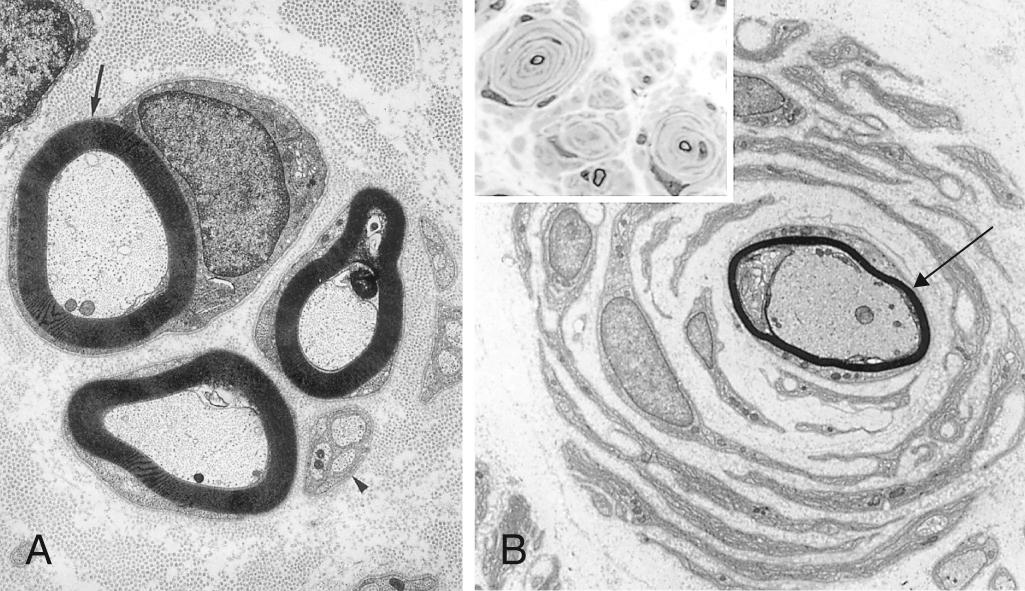
Systemic autoimmune diseases like rheumatoid arthritis, Sjögren syndrome, or systemic lupus erythematosus may be associated with peripheral neuropathies that often take the form of distal sensory or sensorimotor polyneuropathies. These neuropathies are distinct from vasculitic peripheral neuropathies, which can arise as secondary manifestations of these same diseases.
Vasculitis is a noninfectious inflammation of blood vessels that can involve and damage peripheral nerves. About one-third of patients with vasculitis, depending on the type of vasculitis, have peripheral nerve involvement, and neuropathy may be the presenting feature. Vasculitis often presents as mononeuritis multiplex, but mononeuritis and polyneuropathy are also encountered.
When peripheral neuropathy occurs in systemic vasculitis, it is most common in the MPO-ANCA–associated vasculitides (microscopic polyangiitis and eosinophilic granulomatosis with polyangiitis/Churg-Strauss syndrome) and polyarteritis nodosa and much less common in PR3-ANCA–associated granulomatosis with polyangiitis. The most common form of vasculitis associated with peripheral neuropathy is a localized form referred to as nonsystemic vasculitic neuropathy, which is not associated with any anti-neutrophil cytoplasmic antibodies (ANCAs). Regardless of the type of vasculitis, peripheral nerves involved by vasculitis typically show patchy axonal degeneration and loss, with some fascicles being more severely affected than others. Perivascular inflammatory infiltrates are often present. Identification of blood vessels with characteristic forms of acute or chronic damage ( Chapter 11 ) helps establish the diagnosis.
Many infectious processes affect peripheral nerves. Among these, leprosy, diphtheria, and varicella-zoster cause relatively specific pathologic changes in nerves that are the focus here. Each of these disorders is also discussed in more detail in Chapter 8 .
Peripheral nerves are involved in both lepromatous and tuberculoid leprosy (discussed in Chapter 8 ).
In lepromatous leprosy, Schwann cells are invaded by Mycobacterium leprae, which proliferate and eventually infect other cells. There is evidence of segmental demyelination and remyelination and loss of both myelinated and unmyelinated axons. As the infection advances, endoneurial fibrosis and multilayered thickening of the perineurial sheaths occur. Affected individuals develop a symmetric polyneuropathy that is most severe in the relatively cool distal extremities and in the face because lower temperatures favor mycobacterial growth. The infection prominently involves pain fibers, and the resulting loss of sensation contributes to injury, since the patient is rendered unaware of injurious stimuli and damaged tissues. Thus, large traumatic ulcers may develop.
Tuberculoid leprosy is characterized by an active cell-mediated immune response to M. leprae that usually manifests as dermal nodules containing granulomatous inflammation. The inflammation injures cutaneous nerves in the vicinity; axons, Schwann cells, and myelin are lost; and there is fibrosis of the perineurium and endoneurium. In tuberculoid leprosy, affected individuals have much more localized nerve involvement.
Lyme disease causes various neurologic manifestations in the second and third stages of the disease. These include polyradiculoneuropathy and unilateral or bilateral facial nerve palsies.
Patients infected with human immunodeficiency virus (HIV) develop several patterns of peripheral neuropathy that are poorly understood, but all appear to be related in some way to immune dysregulation. Early-stage HIV infection can be associated with mononeuritis multiplex and demyelinating disorders that may resemble Guillain-Barré syndrome or chronic inflammatory demyelinating polyradiculoneuropathy. More commonly, later stages of HIV infection are associated with a distal sensory neuropathy that is often painful.
Peripheral nerve dysfunction results from the effects of the diphtheria exotoxin. It produces an acute peripheral neuropathy associated with prominent bulbar and respiratory muscle dysfunction, which can lead to death or long-term disability. The mechanism of action of diphtheria toxin is described in Chapter 8 . Diphtheria is most commonly found in low income countries and is a continuing medical problem because of incomplete immunization or waning immunity in adults.
Varicella-zoster is one of the most common viral infections of the peripheral nervous system. Following chickenpox, a latent infection persists within neurons of sensory ganglia. If the virus is reactivated, sometimes many years later, it may be transported along the sensory nerves to the skin. Here it infects keratinocytes, leading to a painful, vesicular skin eruption in a distribution that follows sensory dermatomes (shingles). Most common is the involvement of thoracic or trigeminal nerve dermatomes. The factors underlying reactivation of the virus are not fully understood, but decreased cell-mediated immunity is suspected to play a role. In a small proportion of patients, weakness is also apparent in the same distributions. Affected ganglia show neuronal death, usually accompanied by abundant mononuclear inflammatory cell infiltrates; focal necrosis and hemorrhage may also be found. Peripheral nerves show degeneration of the axons that belong to the dead sensory neurons. Focal destruction of the large motor neurons of the anterior horns or cranial nerve motor nuclei may be seen at the corresponding levels. Intranuclear inclusions generally are not found in the peripheral nervous system.
Diabetes is the most common cause of peripheral neuropathy. The prevalence of this complication depends on the duration of the disease; up to 50% of patients with diabetes overall and up to 80% of those who have had the disease for more than 15 years have clinical evidence of peripheral neuropathy. Patients with both type 1 and type 2 diabetes are affected ( Chapter 24 ). Several distinct clinicopathologic patterns of diabetes-related peripheral neuropathy are recognized (described later), but the most common by far is an ascending distal symmetric sensorimotor polyneuropathy.
The mechanism of diabetic neuropathy is complex and not completely resolved; both metabolic and secondary vascular changes are believed to contribute to the damage of axons and Schwann cells. Hyperglycemia causes the nonenzymatic glycosylation of proteins, lipids, and nucleic acids. The resulting advanced glycosylation end-products (AGEs) may interfere with normal protein function and activate inflammatory signaling through the receptor for the AGE. Excess glucose within cells is reduced to sorbitol, a process that depletes NADPH and increases intracellular osmolality. These and other metabolic disturbances may predispose peripheral nerves to injury by reactive oxygen species. In addition, the vascular injuries that occur in chronic diabetes due to hyperlipidemia and other metabolic alterations may cause ischemic damage of the nerves.
In individuals with a distal symmetric sensorimotor neuropathy, the predominant pathologic finding is an axonal neuropathy. Nerve biopsies show reduced numbers of axons. Variable degrees of ongoing axonal damage, marked by degenerating myelin sheaths and regenerative axonal clusters, may be present. Endoneurial arterioles show thickening, hyalinization, and intense periodic acid–Schiff positivity of their walls and extensive reduplication of basement membranes ( Fig. 27.6 ).
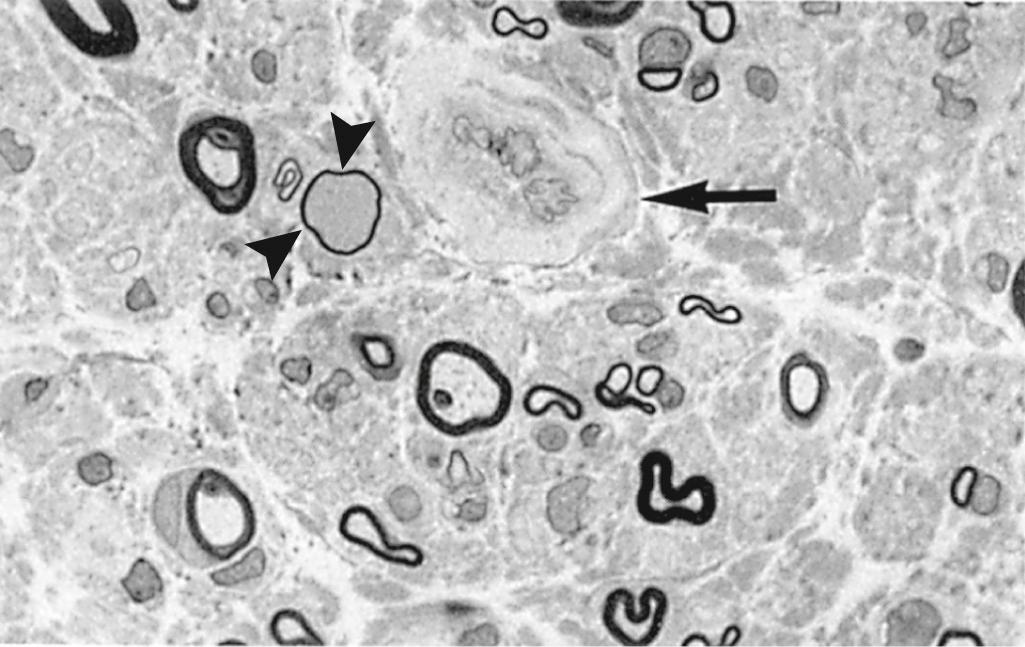
Distal symmetric diabetic polyneuropathy typically presents with sensory symptoms like numbness, loss of pain sensation, difficulty with balance, and paresthesias or dysesthesias. Paresthesias or dysesthesias (abnormal painful sense of touch) are so-called “positive” symptoms—painful sensations that result from abnormal discharges of damaged nerves. Neuropathy leads to considerable morbidity, in particular an increased susceptibility to foot and ankle fractures and chronic skin ulcers, which may eventually lead to amputations.
Another manifestation is dysfunction of the autonomic nervous system; this affects 20% to 40% of individuals with diabetes mellitus, nearly always in association with a distal sensorimotor neuropathy. Diabetic autonomic neuropathy has protean manifestations, including postural hypotension, incomplete emptying of the bladder (resulting in recurrent infections), and sexual dysfunction. Some affected individuals, especially older adults with a long history of diabetes, develop a peripheral neuropathy that manifests with asymmetric presentations, including mononeuropathy, cranial neuropathy, and radiculoplexus neuropathy . The last-mentioned is a devastatingly painful acute disorder that presents in the distribution of the brachial or lumbosacral nerve plexus. It is often monophasic and can improve over several months. These asymmetric manifestations may be caused by microvascular disease.
A diverse group of metabolic, hormonal, and nutritional disorders are associated with peripheral neuropathy, including the following:
Uremic neuropathy. Most individuals with renal failure have a peripheral neuropathy. Typically this is a distal, symmetric neuropathy that may be asymptomatic or may be associated with muscle cramps, distal dysesthesias, and diminished deep tendon reflexes. In these patients, axonal degeneration is the primary event; occasionally there is secondary demyelination. Regeneration and recovery are common after dialysis.
Thyroid dysfunction. Hypothyroidism can lead to compression mononeuropathies such as carpal tunnel syndrome or cause a distal symmetric predominantly sensory polyneuropathy. In rare cases, hyperthyroidism is associated with a neuropathy resembling Guillain-Barré syndrome.
Vitamin B 12 (cyanocobalamin) deficiency classically results in subacute combined degeneration with damage to long tracts in the spinal cord ( Chapter 28 ) and also peripheral nerves.
Deficiencies of vitamin B 1 (thiamine), vitamin B 6 (pyridoxine), folate, copper, and zinc all have been associated with peripheral neuropathy.
Peripheral neuropathies may appear after exposure to industrial or environmental chemicals, biologic toxins, or therapeutic drugs. Important causes of toxic peripheral nerve damage include alcohol (independent of associated nutritional deficiencies), heavy metals (lead, mercury, arsenic, and thallium), and organic solvents. Various medications can cause toxic nerve damage, but the most notorious are chemotherapeutic agents. These include vinca alkaloids and taxanes, microtubule inhibitors that interfere with axonal transport, and cisplatin, which may cause a neuronopathy.
Become a Clinical Tree membership for Full access and enjoy Unlimited articles
If you are a member. Log in here